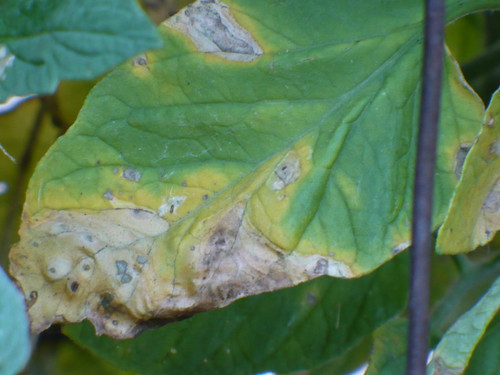Watch for Diseases in Your Garden
As nice as the rain and hot-but-not-scorching weather is, it is creating something of a perfect storm for tomato diseases this summer. Our two most common tomato diseases are Septoria Leaf Spot and Early Blight. While they are two different diseases, we usually talk about them as one disease because they develop in the same conditions and have the same overall effects on the tomato plants.
 This is a tomato leaf that is infected with Early Blight. The lesions usually have concentric circles, and spread to have something of a V-shape on the edge of a leaf. In contrast, Septoria Leaf Spot has small round spots over the whole leaf. Some years we see more of one or the other. Some years we have both. The disease typically starts on the lower leaves of the plant and works up the plant. Most of the time, we don’t really start noticing a problem until the first infected leaves start to turn yellow and die.
This is a tomato leaf that is infected with Early Blight. The lesions usually have concentric circles, and spread to have something of a V-shape on the edge of a leaf. In contrast, Septoria Leaf Spot has small round spots over the whole leaf. Some years we see more of one or the other. Some years we have both. The disease typically starts on the lower leaves of the plant and works up the plant. Most of the time, we don’t really start noticing a problem until the first infected leaves start to turn yellow and die.
The disease spreads from splashing water, which is why it is usually worse when we get rain. It also requires humidity and warm nights, which we have had in spades the past week! We have also had lots of dew, which is great for disease development.
As with most garden problems, the best thing to do is to try to prevent the disease from starting. There are a number of cultural practices that can help prevent these diseases or reduce their spread.
1. Mulch under plants to prevent water splashing from the soil onto lower leaves. (The disease overwinters on plant debris, often in the soil. No, there isn’t any soil treatment.)
2. Use cages, staking, or some method to help your plants grow upright rather than sprawling on the ground.
3. Space your tomato plants 2-3 feet apart to promote airflow.
4. Water the soil and avoid getting water on the leaves if at all possible when watering.
5. Prune out suckers below the first flower cluster (especially on indeterminate tomatoes) to promote airflow.
6. Scout regularly for signs of disease and remove infected leaves right away.
7. Rotate where you plant your tomatoes as much as possible.
8. Remove infected plants from your garden every year at the end of the season and do not compost them.
Sometimes, even if we do everything “right” we still end up with these diseases, especially when the weather conditions are ideal for disease to develop.
The good news is that these diseases usually do not kill the plants, and they will not spread as quickly if it turns hot and dry. The worst damage (other than a weaker plant that is more susceptible to spider mites) is that if there is too much defoliation, then there is a much higher risk of sunscald on the fruit.
Using Fungicides
If you want to try to prevent development of these diseases, now is the time to start spraying a fungicide. You will probably need to spray once a week as long as we are experiencing this type of weather pattern.
If you are looking for organic options, you can use a copper-containing fungicide, such as a Copper Soap. There is also a biological fungicide that contains Bacillus subtilis, usually sold under the name Serenade. The key with the organic options is to use them regularly, especially before you have lots of disease, because they will work better if the disease pressure is low.
Conventional fungicides that are commonly used are chlorothalonil and maneb, which are found in several different garden products. They are a little bit stronger, but will still be most effective if they are used preventatively.
Fungicides are not usually curative, they just prevent the further spread of the disease. None of them are perfect either – the weather and how you apply them affect the efficacy of the treatment.
On that happy note, I hope your gardens all got a good drink this morning! We had about 1.5″ in the rain gauge, so no watering for us for a few days.
Posted on June 5, 2014, in Plant Problems & Diseases and tagged disease, plant problems, Tomatoes. Bookmark the permalink. 1 Comment.




Pingback: Tomato Issues Begin! | East Sac Edible